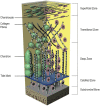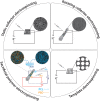Electrospun Polymers in Cartilage Engineering-State of Play
- PMID: 32133352
- PMCID: PMC7039817
- DOI: 10.3389/fbioe.2020.00077
Electrospun Polymers in Cartilage Engineering-State of Play
Abstract
Articular cartilage defects remain a clinical challenge. Articular cartilage defects progress to osteoarthritis, which negatively (e.g., remarkable pain, decreased mobility, distress) affects millions of people worldwide and is associated with excessive healthcare costs. Surgical procedures and cell-based therapies have failed to deliver a functional therapy. To this end, tissue engineering therapies provide a promise to deliver a functional cartilage substitute. Among the various scaffold fabrication technologies available, electrospinning is continuously gaining pace, as it can produce nano- to micro- fibrous scaffolds that imitate architectural features of native extracellular matrix supramolecular assemblies and can deliver variable cell populations and bioactive molecules. Herein, we comprehensively review advancements and shortfalls of various electrospun scaffolds in cartilage engineering.
Keywords: cartilage engineering; electrospinning; fibrous scaffolds; functionalised scaffolds; in vivo models.
Copyright © 2020 Yilmaz and Zeugolis.
Figures
Similar articles
-
Electrospun fibrous scaffolds for bone and cartilage tissue generation: recent progress and future developments.Tissue Eng Part B Rev. 2012 Dec;18(6):478-86. doi: 10.1089/ten.TEB.2012.0096. Epub 2012 Aug 3. Tissue Eng Part B Rev. 2012. PMID: 22738358 Review.
-
Methods of producing three dimensional electrospun scaffolds for bone tissue engineering: A review.Proc Inst Mech Eng H. 2022 Jan 20:9544119211069463. doi: 10.1177/09544119211069463. Online ahead of print. Proc Inst Mech Eng H. 2022. PMID: 35048771
-
Fabrication and characterization of six electrospun poly(alpha-hydroxy ester)-based fibrous scaffolds for tissue engineering applications.Acta Biomater. 2006 Jul;2(4):377-85. doi: 10.1016/j.actbio.2006.02.005. Epub 2006 May 6. Acta Biomater. 2006. PMID: 16765878
-
Microstructure and properties of nano-fibrous PCL-b-PLLA scaffolds for cartilage tissue engineering.Eur Cell Mater. 2009 Oct 27;18:63-74. doi: 10.22203/ecm.v018a06. Eur Cell Mater. 2009. PMID: 19859871
-
Cell-matrix mechanical interaction in electrospun polymeric scaffolds for tissue engineering: Implications for scaffold design and performance.Acta Biomater. 2017 Mar 1;50:41-55. doi: 10.1016/j.actbio.2016.12.034. Epub 2016 Dec 21. Acta Biomater. 2017. PMID: 28011142 Review.
Cited by
-
Electrospinning and 3D bioprinting for intervertebral disc tissue engineering.JOR Spine. 2020 Aug 6;3(4):e1117. doi: 10.1002/jsp2.1117. eCollection 2020 Dec. JOR Spine. 2020. PMID: 33392454 Free PMC article. Review.
-
Bacterial Biofilm Formation Using PCL/Curcumin Electrospun Fibers and Its Potential Use for Biotechnological Applications.Materials (Basel). 2020 Dec 6;13(23):5556. doi: 10.3390/ma13235556. Materials (Basel). 2020. PMID: 33291216 Free PMC article.
-
Evaluation of Electrospun PCL-PLGA for Sustained Delivery of Kartogenin.Molecules. 2022 Jun 10;27(12):3739. doi: 10.3390/molecules27123739. Molecules. 2022. PMID: 35744864 Free PMC article.
-
Electrospinning Inorganic Nanomaterials to Fabricate Bionanocomposites for Soft and Hard Tissue Repair.Nanomaterials (Basel). 2023 Jan 2;13(1):204. doi: 10.3390/nano13010204. Nanomaterials (Basel). 2023. PMID: 36616113 Free PMC article. Review.
-
Recent advancements in cartilage tissue engineering innovation and translation.Nat Rev Rheumatol. 2024 Jun;20(6):323-346. doi: 10.1038/s41584-024-01118-4. Epub 2024 May 13. Nat Rev Rheumatol. 2024. PMID: 38740860 Free PMC article. Review.
References
-
- Alves da Silva M., Martins A., Costa-Pinto A. R., Monteiro N., Faria S., Reis R. L., et al. . (2017). Electrospun nanofibrous meshes cultured with Wharton's jelly stem cell: an alternative for cartilage regeneration, without the need of growth factors. Biotechnol. J. 12:1700073. 10.1002/biot.201700073 - DOI - PubMed
Publication types
LinkOut - more resources
Full Text Sources




